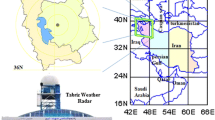Abstract
This study offers a new method for estimating High-Frequency (HF) radar surface current velocity error in data comparisons with other types of instrumentation. A new method is needed in order to remove the zero-mean random spatial and temporal fluctuations present in surface-current measurements from all sensors. Conventional methods for calculating radar error when comparing with another instrument have included their root mean square differences and scatter plots that provide correlation coefficient and slope/intercept of the regression line. It seems that a meaningful estimate of radar error should attempt to remove both sensors’ zero mean random fluctuations, inasmuch as possible. We offer and compare a method that does this. The method was tested on data collected in the Central San Francisco Bay, where GPS surface-drifter deployments were conducted within the coverage of four 42 MHz radars over six days in October of 2008. Drifters were continuously deployed in these areas over the sampling days, providing 525 usable drifter measurements. Drifter and radar measurements were averaged into thirty-minute time bins. The three-day long-term averages from the sampling areas were then subtracted from the thirtyminute averages to remove biases associated with comparisons done with short, disjoint time-sample periods. These were then used to develop methods that give radar error or bias after the random fluctuations have been removed. Results for error estimates in this study are commensurate with others where random fluctuations have been filtered, suggesting they are valid. The estimated error for the radars in the SF Bay is low, ranging from −7.57 cm/s to 0.59 cm/s.
Similar content being viewed by others
References
Chapman R, Shay L, Graber H, Edson J, Karachintsev A, Trump C, Ross D (1997) On the accuracy of HF radar surface current measurements: Intercomparisons with ship-based sensors. J Geophys Res 102:18737–18748
Kaplan D, Largier J, Botsford L (2005) HF radar observation of surface circulation off Bodega Bay (Northern California, USA). J Geophys Res 110:1–25
Kohut J, Glenn S (2003) Improving HF radar surface current measurements with measured antenna beam patterns. J Atmos Ocean Tech 20:1303–1316
Laws K, Paduan J, Vesecky J (2010) Estimation and assessment of errors related to antenna pattern distortion in CODAR SeaSonde high-frequency radar ocean surface current measurements. J Atmos Ocean Tech 27:1029–1043
Mariette V, Cochin V, Thomas N, Gurgel K-W (2006) Surveillance littorale operationnelle (SURLITOP) — Operational coastal monitoring. In: Radiowave Oceanography Workshop (ROW6), Hamburg, Germany. http://www.satlab.hawaii.edu/row/followlogin instructions: row2006, hamburg
Ohlmann C, White P, Sybrandy A, Niiler P (2005) GPS-cellular drifter technology for coastal ocean observing systems. J Atmos Ocean Tech 22:1381–1388
Ohlmann C, White P, Washburn L, Terrill E, Emery B, Otero M (2007) Interpretation of coastal HF radar-derived surface currents with high-resolution drifter data. J Atmos Ocean Tech 24:666–680
Paduan J, Rosenfeld L (1996) Remotely sensed surface currents in Monterey Bay from shore-based HF radar (CODAR). J Geophys Res 101: 20669–20686
Paduan J, Kim K, Cook M, Chavez F (2006) Calibration and validation of direction-finding high-frequency radar ocean surface current observations. IEEE J Oceanic Eng 31:862–875
Pawlowicz R, Beardsley B, Lentz S (2002) Classical tidal harmonic analysis including error estimates in MATLAB using T_TIDE. Comput Geosci 28:929–937
Teague C (1986) Multifrequency HF radar observations of currents and current shears. IEEE J Oceanic Eng 11:258–269
Ullman D, O’Donnell J, Edwards C, Fake T, Morschauser D, Sprague M, Allen A, Krenzien B (2003) Use of Coastal Ocean Dynamics Applications Radar (CODAR) technology in US Coast Guard search and rescue planning. US Coast Guard Research and Development Center, Report No. CG-D-09-03
Author information
Authors and Affiliations
Corresponding author
Rights and permissions
About this article
Cite this article
Hubbard, M., Barrick, D., Garfield, N. et al. A new method for estimating high-frequency radar error using data from Central San Francisco Bay. Ocean Sci. J. 48, 105–116 (2013). https://doi.org/10.1007/s12601-013-0009-y
Received:
Revised:
Accepted:
Published:
Issue Date:
DOI: https://doi.org/10.1007/s12601-013-0009-y



